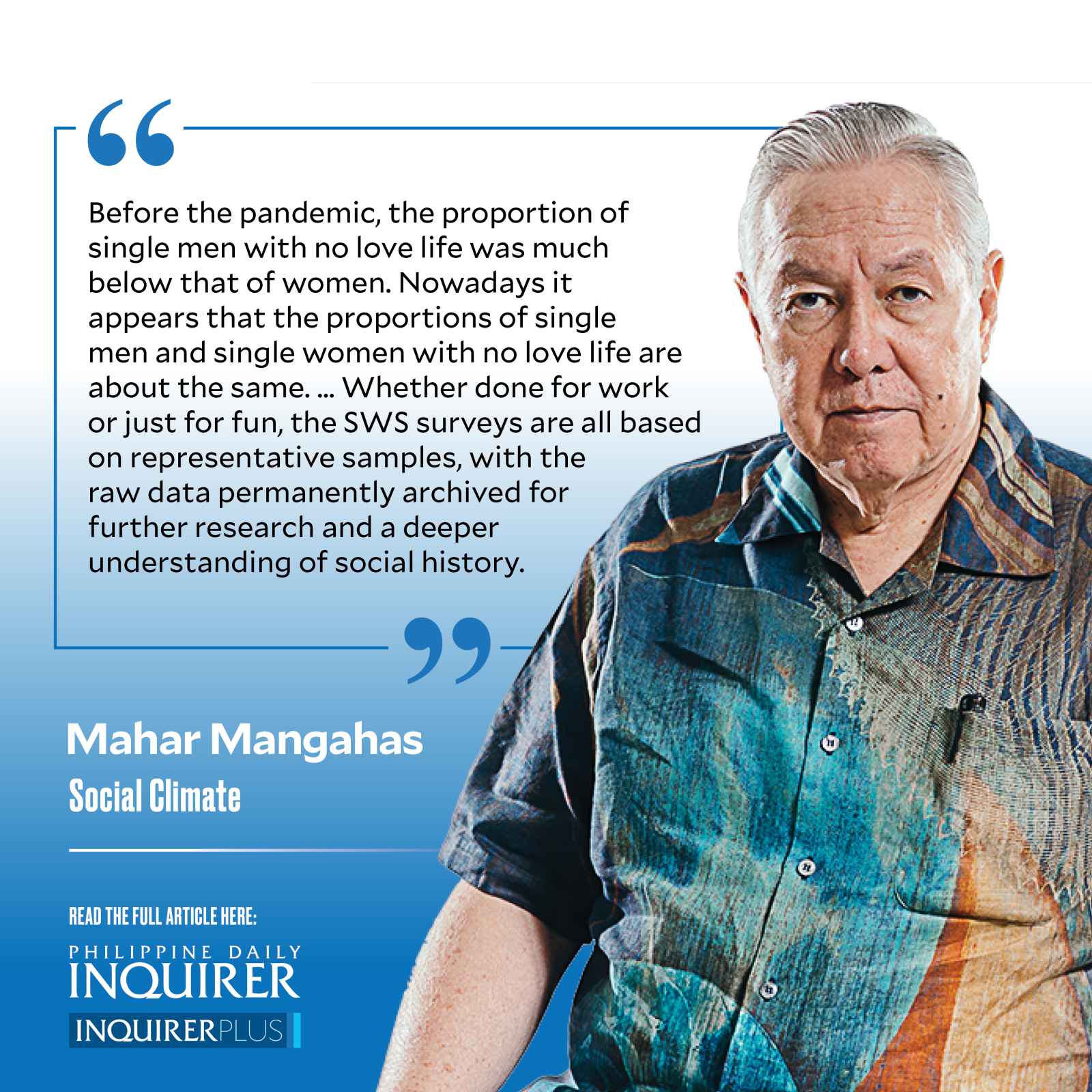Surveying for Valentine’s Day

The Social Weather Report (SWR) surveys are done by SWS on its own account, for its mission of public sharing. The SWR series has been quarterly since 1992, after having been semi-annual in 1986-91. (Precursor surveys in 1983-85, by various institutions, obtained linkable data.)
Done around December each year, the fourth-quarter SWR round is appropriate for surveying expectations for coming holidays like Christmas, New Year, Valentine’s, and Easter. The corresponding findings are programmed for release before Dec. 25, Dec. 31, Feb. 14, and whenever is Easter Sunday.
Unrequited love. Hence last week’s Valentine’s infographic, “Fourth Quarter 2022 Social Weather Survey: 3 out of 10 adult Filipinos have experienced unrequited love” (www.sws.org.ph, 2/10/2023). The finding in the title came from the Yes/No question: “Kayo po ba ay nakaranas ng pagmamahal na hindi nasuklian?” Aside from the 30 percent who said Yes, there was 59 percent who said No, and 10 percent who said they heard of the concept for the first time when interviewed (on Dec. 10-14, 2022).
Frustration in love is most common in the Visayas (42 percent). It is less in Balance Luzon (24 percent) and Metro Manila (26 percent), and slightly above average in Mindanao (36 percent). The SWR is stratified by area, so this is a reliable comparison. No difference between men and women, by the way.
Confession of love. The frustration question, asked by SWS for the first time, was the first of three items in the Valentine module. The second item, also new, was a Yes/No question on ever having confessed love to a friend: “Naranasan ba ninyong umamin ng pag-ibig sa isang kaibigan?”
To this, 33 percent said Yes—40 percent of men, 25 percent of women. The most expressive are Visayans (50 percent), which connects to their being the most frustrated.
Happiness in love life. To the third and final question in the Valentine module, regarding love life, 57 percent said they were very happy (napakasaya), 25 percent said they wish they could be happier (sana mas masaya pa), and 17 percent said they had none (walang buhay pag-ibig).
Equally very happy are Mindanao (61 percent), Visayas (58 percent), and Balance Luzon (57 percent); a bit behind is Metro Manila (50 percent). Metro Manila (22 percent) and Visayas (20 percent) are the most lacking in love life. Mindanao is the least lacking (11 percent). Balance Luzon is average (18 percent).
This is an old survey item that SWS fielded in 2002, 2004, annually in 2010-12, and annually in 2014-22. Those without a love life were a high 17-18 percent in 2020-22; before the pandemic, they had been 9-14 percent. What I notice is that those wishing for a happier love life are at a new record low 25 percent, down from the previous record of 28 percent a year ago. The record high was 44 percent in 2004.
Before the pandemic, the proportion of single men with no love life was much below that of women. Nowadays it appears that the proportions of single men and single women with no love life are about the same.
Previous Valentine surveys. The annual Valentine module gives the SWS staff an opportunity to satisfy their personal curiosity. The 2021 survey was about how the holiday would be celebrated; the top answer was going to church. The 2020 survey said that four-fifths of adults were more attracted to brains than to beauty. The 2019 survey found that women prefer to be younger than their men, while men are not too particular about age gap. Just look through the website circa Feb. 14 each year.
Question wording is deliberately simple. For fieldwork, an interviewer is trained to follow the questionnaire word for word. She—women make better field workers than men—may not try to explain the words in a question; she may only repeat the question.
Note that the item on requited love used the word pagmamahal, whereas the item on love life used the word pag-ibig. I think the former can include platonic love, whereas the latter normally includes physical love. What matters is how a word is understood by the respondents. Users of survey research are entitled to know the exact phrasing of the questions, in the original language.
With respect to “love life,” some fielded versions are: buhay-pag-ibig (Filipino/Tagalog), biag ti-panagayat (Iluko), kinabuhi han paghigugma (Waray), buhi nga paghigugma (Cebuano), kabuhi paghigugma (Hiligaynon), buhay pagkamoot (Bicol), uyag uyag a pamusungan (Maguindanaon), kabuhi sin paglasa (Tausug), and kakakabaya-i (Maranao).
Whether done for work or just for fun, the SWS surveys are all based on representative samples, with the raw data permanently archived for further research and a deeper understanding of social history.
——————
Contact: mahar.mangahas@sws.org.ph.




















